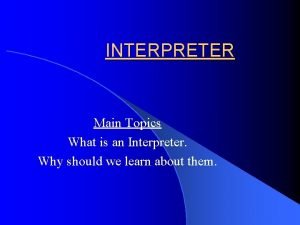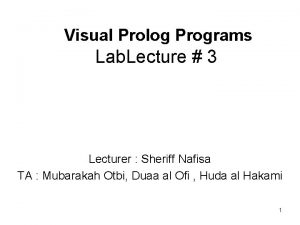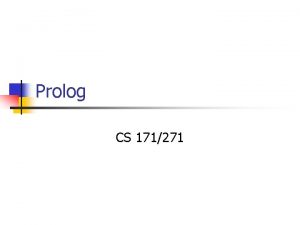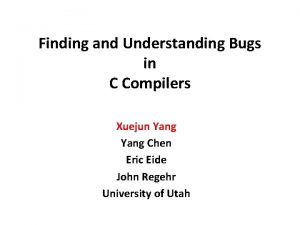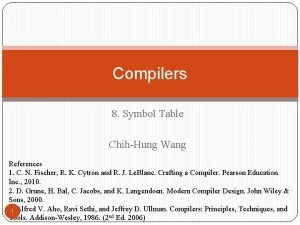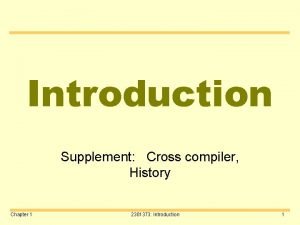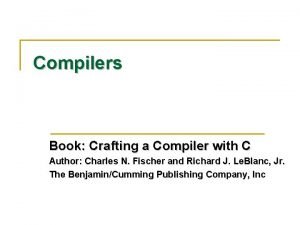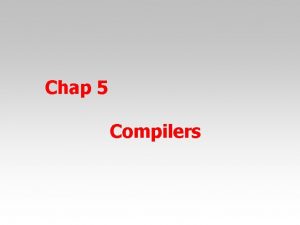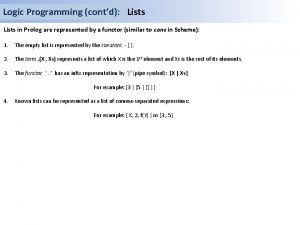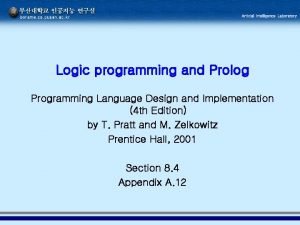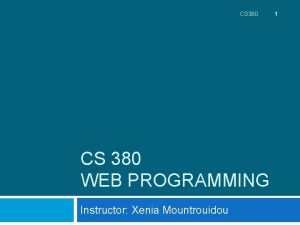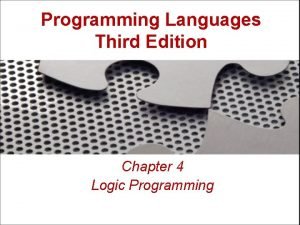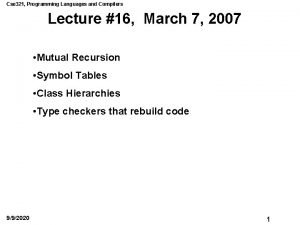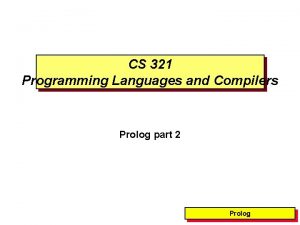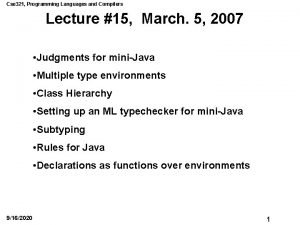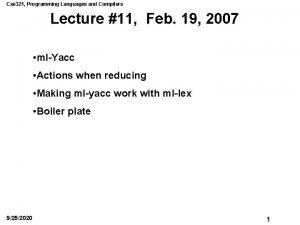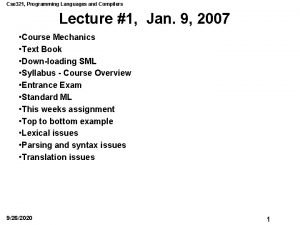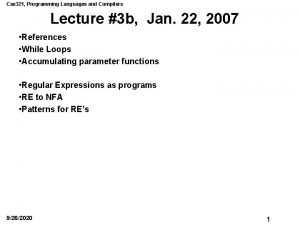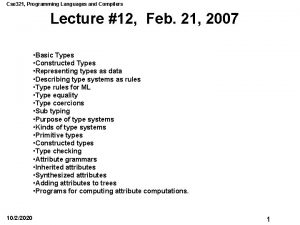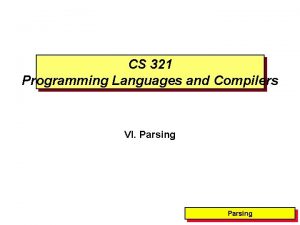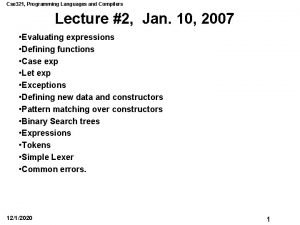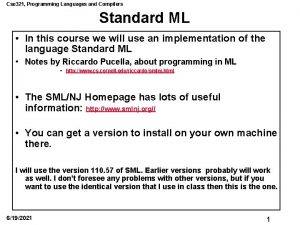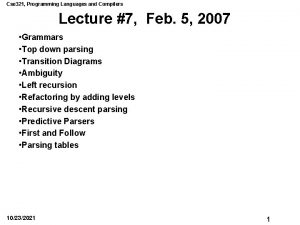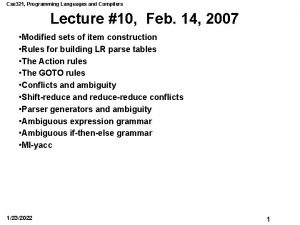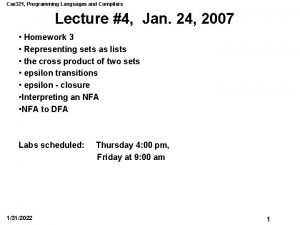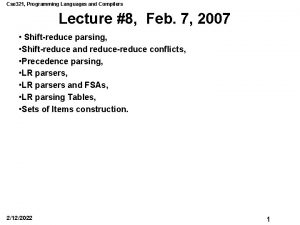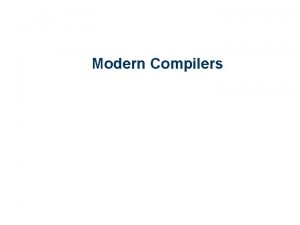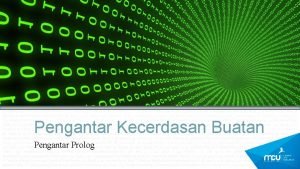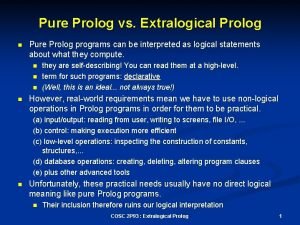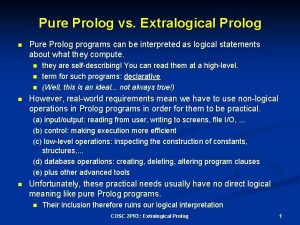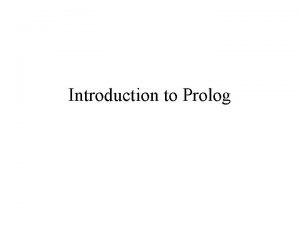CS 321 Programming Languages and Compilers Prolog Prolog










![Recursive Inference • Example, given X[mortal(X) mortal(son_of(X))] mortal(plato) derive: mortal(son_of(plato)) (using X=plato) mortal(son_of(plato))) (using Recursive Inference • Example, given X[mortal(X) mortal(son_of(X))] mortal(plato) derive: mortal(son_of(plato)) (using X=plato) mortal(son_of(plato))) (using](https://slidetodoc.com/presentation_image/3978ef8e9e8d548e15d279b373edc9aa/image-11.jpg)




















![Recursion mylength( [ ], 0). mylength( [X | Y], N): –mylength(Y, Nx), N is Recursion mylength( [ ], 0). mylength( [X | Y], N): –mylength(Y, Nx), N is](https://slidetodoc.com/presentation_image/3978ef8e9e8d548e15d279b373edc9aa/image-32.jpg)
![Recursion mymember( X , [X | _ ] ). mymember( X , [ _ Recursion mymember( X , [X | _ ] ). mymember( X , [ _](https://slidetodoc.com/presentation_image/3978ef8e9e8d548e15d279b373edc9aa/image-33.jpg)
- Slides: 33

CS 321 Programming Languages and Compilers Prolog

Prolog • PROgramming LOGic • Algorithm = Logic + Control • Logic programming deals with computing relations rather than functions. • To understand Prolog one must understand – logic: the rules of deduction in first order logic – control: the way Prolog implements this logic, I. e. the search strategy that Prolog adopts. 2 Prolog

What is Prolog • Prolog is a ‘typeless’ language with a very simple syntax. • Prolog is a logical programming language. • Prolog uses – Horn clauses – implements resolution » using a “depth first” strategy » unification • Atoms, lists and records are the data structures. 3 Prolog

Declarative Languages • Also known as logic programming • Examples: Prolog, SQL, Datalog. • Typical of database systems and artificial intelligence. • Declarative specifications: Specify what you want, not how to compute it. • E. g. Find X and Y such that 3*X+2*Y=1 X-Y=4 4 Prolog

Classical First-Order Logic • simplest form of logical statements is an atomic formula. e. g. man(tom) woman(mary) married(tom, mary) • More complex formulas can be built up using logical connectives: 5 Prolog

Examples of First Order Logic smart(tom) dumb(tom) smart(tom) tall(tom) dumb(tom) X married(tom, X) X loves(tom, X) X [married(tom, X) female(X) human(X)] 6 Prolog

Logical Implication rich(tom) smart(tom) This implies that if tom is smart, then he must be rich. So, we often write this as rich(tom) smart(tom) In general, P Q and Q P are abbreviations for P Q Examples: X[(person(X) smart(X)) rich(X)] X mother(john, X) X [mother(john, X) Y[mother(john, Y) Y=X] ] 7 Prolog

Horn Rules • Logic programming is based on formulas called Horn rules. These have the form • Examples: X, Y[A(X) B(X, Y) C(Y)] X[A(X) B(X)] X[A(X, d) B(X, e)] A(c, d) B(d, e) X A(X, d) A(c, d) • Note that atomic formulas are also Horn rules, often called facts. • A set of Horn rules is called a Logic Program. 8 Prolog

Logical Inference with Horn Rules • Logic programming is based on a simple idea: From rules and facts, derive more facts. • Example 1. Given the facts A, B, C, D, and the rules: 1. E A B 2. F C D 3. G E F From 1, derive E; from 2, derive F; from 3, derive G. 9 Prolog

Logical Inference • Example 2: Given these facts: man(plato) man(socrates) and this rule: X [man(X) mortal(X)] derive: mortal(plato), mortal(socrates). 10 Prolog
![Recursive Inference Example given XmortalX mortalsonofX mortalplato derive mortalsonofplato using Xplato mortalsonofplato using Recursive Inference • Example, given X[mortal(X) mortal(son_of(X))] mortal(plato) derive: mortal(son_of(plato)) (using X=plato) mortal(son_of(plato))) (using](https://slidetodoc.com/presentation_image/3978ef8e9e8d548e15d279b373edc9aa/image-11.jpg)
Recursive Inference • Example, given X[mortal(X) mortal(son_of(X))] mortal(plato) derive: mortal(son_of(plato)) (using X=plato) mortal(son_of(plato))) (using X=son_of(plato)) mortal(son_of(son_of(plato)))) (using X=son_of(plato))) 11 Prolog

Logic Programming • Horn rules correspond to programs, and a form of Horn inference corresponds to execution. • For example, consider the rule: X, Y p(X) q(X, Y) r(X, Y) s(X, Y) • This rule can be interpreted as a program where – – p is the program name, q, r, s are subroutine names, X is a parameter of the program, and Y is a local variable. 12 Prolog

Non-Horn Formulas • The following formulas are not Horn: A B A B C X[A(X) B(X)] A (B C) X[flag(X) [red(X) white(X)]] X Y[wife(X) married(X, Y)] 13 Prolog

Non-Horn Inference • Non-Horn inference is more complex that with Horn formulas alone. Example: A B A C B C (non-Horn) We can infer A, but only by doing case analysis either B or C is true. if B then A if C then A Therefore, A. • Non-Horn formulas do not correspond to programs, and non-Horn inference does not correspond to execution. 14 Prolog

Logical Equivalence • Many non-Horn formulas can be put into Horn form by using either: – logical equivalence – Skolemization (a subject for a later course). • Example of logical equivalence: A B A ( B) A B B A B A (Horn) 15 Prolog

Logical Laws A A (A B) A B A (B C) (A B) (A C) A B • Example using logical equivalence and laws: A (B C) A ( B) ( C) (A B) (A C) (Horn) 16 Prolog

Non-convertible Formulas • In general, rules of the following form cannot be converted into Horn form: For example, (A B) (C D) (A B) C (A B) i. e. , if it is possible to infer a non-trivial disjunction from a set of formulas, then the set is inherently non-Horn. 17 Prolog

Prolog • Syntax is Horn clauses of terms. • Proof process involves SLD Resolution – unification + substitution: pattern matching between terms + binding unresolved variables as needed. – automatic backtracking: if one attempt fails, try again until all search paths are exhausted. SLD stands for Selecting a literal, using a Linear strategy, restricted to Definite clauses. The name SLD was coined by researchers in automatic theorem proving before the birth of logic programming 18 Prolog

Prolog Notation • For convenience, we don’t write the universal quantifiers, so a rule: X [p(X) (q(X) r(X))] is written as p(X) q(X), r(X). • We also use the Prolog conventions: – variables begin with upper case (A, B, X, Y, Big, Small, ACE) – constants begin with lower case (a, b, x, y, plato, aristotle) 19 Prolog

Prolog Syntax < fact > < term >. < rule > < term > < query > < terms >. < term > < number : - < terms >. > | < atom > | <variable> | < atom > ( < terms > ) < terms > < term > | < term > , < terms > 20 Prolog

Syntax • Integers: base 10 • atoms: user defined, supplied – name starts with lower case: john, student 2 • Variables – begin with upper case: Who, X – ‘_’ can be used in place of variable name • Structures – student(ali, freshman, 194). • Lists – [x, y, Z ] – [ Head | Tail ] » syntactic sugar for . ( Head, Tail ) – [] 21 Prolog

Prolog Introduction /* list of facts in prolog, stored in an ascii file, ‘family. pl’*/ mother(mary, ann). mother(mary, joe). mother(sue, mar. Y ). father(mike, ann). father(mike, joe). grandparent(sue, ann). /* reading the facts from a file */ 1? - consult ( ‘family. pl’ ). family. pl compiled, 0. 00 sec, 828 bytes 22 Prolog

• Comments are either bound by “/*”, ”*/” or any characters following the “%”. • Structures are just relationships. There are no inputs or outputs for the variables of the structures. • The swipl documentation of the built-in predicates does indicate how the variables should be used. pred(+var 1, -var 2, +var 3). + indicates input variable - indicates output variable • You can also consult a file with a “pl” extension by ? - [family]. 23 Prolog

/* Prolog the order of the facts and rules is the order it is searched in */ /* Variation from pure logic model */ 2 ? - father( X, Y ). X = mike /* italics represents computer output */ Y = ann ; /* I type ‘; ’ to continue searching the data base */ X = mike Y = joe ; no 3 ? - father( X, joe). X = mike ; no 24 Prolog

/* Rules */ parent( X , Y ) : – mother( X , Y ). /* If mother( X , Y ) then parent( X , Y ) */ parent( X , Y ) : – father( X , Y ). /* If the facts are later then grandparent(sue, ann). redundant */ /* if parent( X , Y ) and parent(Y, Z ) then grandparent( X , Z ). */ grandparent( X , Z ) : – parent( X , Y ), parent(Y, Z ). 25 Prolog

‘or’ parent( X , Y ) : – mother( X , Y ); father( X , Y ). has same effect as: parent( X , Y ) : – mother( X , Y ). parent( X , Y ) : – father( X , Y ). 26 Prolog

mother(mary, ann). mother(mary, joe). mother(sue, mar. Y ). father(mike, ann). father(mike, joe). parent( X , Y ) : – mother( X , Y ). parent( X , Y ) : – father( X , Y ). ? - parent( X , joe). X = mary yes parent ( X, joe). mary mother( X , joe). mother( mary, ann). /* fails */ mother (mary, joe). Prolog 27 mary binding Y = joe X= X=

? - parent( X , ann), parent( X , joe). X = mary; X = mike yes ? - grandparent(sue, Y ). Y = ann; Y = joe yes 28 Prolog

/* specification of factorial n! */ factorial(0, 1). factorial(N, M): – N 1 is N – 1, factorial (N 1, M 1), M is N*M 1. 29 Prolog

r 1: r 2: add. To. Set( X, L, L ) : - member( X, L ). add. To. Set( X, L, [X|L] ). ? -add. To. Set(a, [b, c], O). r 1 Pattern r 2 add. To. Set( X, L, [X|L] ) add. To. Set( X, L, L ) unification add. To. Set(a, [b, c], [a|[b, c]] subgoals succeeds member(a, [b, c]). FAILS backtrack 30 Prolog

Recursion in Prolog • trivial, or boundary cases • ‘general’ cases where the solution is constructed from solutions of (simpler) version of the original problem itself. • What is the length of a list ? • THINK: The length of a list, [ e | Tail ], is 1 + the length of Tail • What is the boundary condition? – The list [ ] is the boundary. The length of [ ] is 0. • Where do we store the value of the length? -accumulator -- length( [ ], 0 ). length([H | T], N) : - length(T, Nx), N is Nx + 1 31 Prolog
![Recursion mylength 0 mylength X Y N mylengthY Nx N is Recursion mylength( [ ], 0). mylength( [X | Y], N): –mylength(Y, Nx), N is](https://slidetodoc.com/presentation_image/3978ef8e9e8d548e15d279b373edc9aa/image-32.jpg)
Recursion mylength( [ ], 0). mylength( [X | Y], N): –mylength(Y, Nx), N is Nx+1. ? – mylength( [1, 7, 9], X ). X=3 ? - mylength(jim, X ). no ? - mylength(Jim, X ). Jim = [ ] X=0 32 Prolog
![Recursion mymember X X mymember X Recursion mymember( X , [X | _ ] ). mymember( X , [ _](https://slidetodoc.com/presentation_image/3978ef8e9e8d548e15d279b373edc9aa/image-33.jpg)
Recursion mymember( X , [X | _ ] ). mymember( X , [ _ | Z ] ) : – mymember( X , Z ). % equivalently: However swipl will give a warning % Singleton variables : Y W mymember( X , [X | Y] ). mymember( X , [W | Z ] ) : – mymember( X , Z ). 1? –mymember(a, [b, c, 6] ). no 2? – mymember(a, [b, a, 6] ). yes 3? – mymember( X , [b, c, 6] ). X = b; X = c; X = 6; no 33 Prolog
 Cs 421
Cs 421 Cs 421 programming languages and compilers
Cs 421 programming languages and compilers What is an interpreter
What is an interpreter Domain in prolog
Domain in prolog Visual prolog vs swi-prolog
Visual prolog vs swi-prolog Finding and understanding bugs in c compilers
Finding and understanding bugs in c compilers Symbol table implementation in lex and yacc
Symbol table implementation in lex and yacc Compilers vs interpreters
Compilers vs interpreters Real-time systems and programming languages
Real-time systems and programming languages Advantages of high level language
Advantages of high level language Real time programming language
Real time programming language Compilers binarymove
Compilers binarymove Cousins of compiler
Cousins of compiler Crafting a compiler
Crafting a compiler Functions of compiler
Functions of compiler Explain compiler construction tools
Explain compiler construction tools Multithreaded programming languages
Multithreaded programming languages Prolog programming
Prolog programming Prolog language
Prolog language Cxc it
Cxc it Introduction to programming languages
Introduction to programming languages Plc coding language
Plc coding language Joey paquet
Joey paquet Imperative programming languages
Imperative programming languages Alternative programming languages
Alternative programming languages Types of programming languages
Types of programming languages Transmission programming languages
Transmission programming languages Cse 340 principles of programming languages
Cse 340 principles of programming languages Integral data type is
Integral data type is Xenia programming languages
Xenia programming languages Mainstream programming languages
Mainstream programming languages Vineeth kashyap
Vineeth kashyap Programming languages
Programming languages Programming languages
Programming languages


